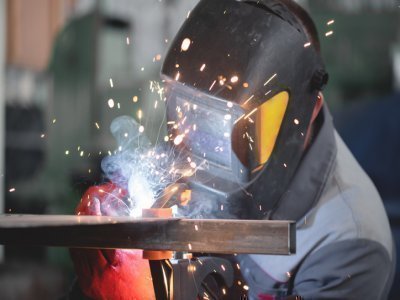How To Protect Your Welders From Cancer
The global reclassification of welding fume as “carcinogenic to humans” in 2017 confirmed what many had suspected for a long time and led to SafeWork Australia publishing a new Code of Practice on Welding Processes. Disappointingly, the 2020 Welding Fume and Respiratory Protection Survey1 showed that only 11% of workplaces had engaged an Occupational Hygienist for advice. It’s clear that we have a long way to go to protect our welders.
As far back as 1980, welders were thought to have a 30 to 40% increased risk of lung cancer compared to the general population. We now know for certain that exposure to welding fume can cause lung cancer and is associated with kidney and bladder cancer whilst the ultraviolet radiation from welding can cause melanoma.
According to Safe Work Australia, the greater the exposure to the carcinogen over a prolonged period of time, the higher the risk of developing cancer. Even short-term exposure may result in eye, nose and throat irritation, dizziness and nausea or metal fume fever.
According to the Cancer Council2, the cancer risk from welding fumes depends on many factors including:
- The type of welding process used
- The material being welded (including any surface coatings or metal treatments)
- The contaminants in the air (for example vapours from solvent cleaners or degreasers)
- The consumables being used
- Shielding flux or gas
- The power settings
- Where the welding is being carried out (outside or in an enclosed space)
- The length of time welding
The Cancer Council also highlights the dangers of the UV radiation generated by welding which they claim can cause eye melanoma, ‘welder’s flash’ or ‘arc eye’ (painful inflammation of the cornea), cataracts (clouding on the lens of the eye), and burns to exposed skin. UV radiation effects depend on:
- The type of welding (electric arc or laser welding)
- The intensity of the radiation
- How long you are exposed to the radiation
- The distance you are from the welding activity
The Role Of Air Monitoring
Air monitoring, by an experienced Occupational Hygienist, determines whether an exposure standard is being exceeded. Under the OHS Regulations, an initial exploratory exposure monitoring exercise may be needed to reach an accurate judgement about the risk to health. The results will then influence the assessment of how well control measures for the welding fume are working and the type of additional controls that may be required.
The current Safe Work Australia Exposure Standard for welding fume in the breathing zone (inside a welder’s helmet when a helmet is worn) must not exceed 5 mg/m3 when calculated over an 8-hour working day. Specific components of welding such as chromium VI (0.05 mg/m3) have more stringent exposure standards. Where there is uncertainty in workers exposure Atmospheric Monitoring by an Occupational Hygienist is recommended to determine controls required to ensure workers are not exposed above the exposure standard and that ensure risk is reduced as far as reasonable practicable.
According to Breathe Freely Australia3, a program of the Australian Institute of Occupational Hygienists, Air Monitoring can be used to:
- Produce the risk assessment for the task
- Select the right fume control solutions
- Check that exposure limits are not exceeded
- Check that controls work properly or if improvements are needed
- Check that new controls work well
- Choose the right level of respiratory protection
- Influence the health surveillance programme
Breathe Freely Australia also highlight that it is wise to use Air Monitoring when:
- Welding coated material, e.g. galvanised steel
- Using metals which have low exposure limits, such as nickel and chromium
- Fume is seen in the air coming away from the welding process
- Fume is seen which isn’t being captured by the existing extraction
- There are concerns about the performance of the existing control measures
- You want to gather information which will help specify further control measures
Welding Safety
Protection of workers directly involved in welding operations should be through the use of PPE with the appropriate level of UV protection. For others their exposure should be limited through:
- Time – least amount of exposure time possible
- Distance – maintaining the greatest physical distance practicable
- Shielding – Using rated welding screen to prevent the transmission of UV radiation
SafeWork Australia revised its Welding processes Code of Practice in 2020 with some minor adjustments and remains a good source of reference for welding health and safety.
In general the following approach to welding safety should be followed:
Elimination
- Consider outsourcing welding processes to an organisation with improved controls.
Substitution
- Substitute welding processes where practicable (eg use submerged arc welding instead of flux-core wire welding or use low fume/less hazardous welding rods).
- Clean base metals to reduce fume generation (coatings, oils, greases, mill scale, and solvents).
Isolation
- Locate welding operations away from other workers (eg use screens, curtains, or distance from other work stations, aisles, or walkways).
Engineering
- Clean base metals to reduce fume generation (oils, greases, mill scale, and solvents).
Administration
- Clean base metals to reduce fume generation (oils, greases, mill scale, and solvents).
- Encourage job rotation and/or job sharing.
PPE
- Utilise appropriate respiratory protective equipment. At a minimum this should be a P2 mask designed to protect against thermally generated particulates.
- PAPRs which integrate into a welding helmet and allow for additional filter cartridges beyond simple particulate protection are becoming more common and provide improved protection.
Welders deserve to feel safe at work and you have a responsibility to ensure that you keep their work environment free of risk. In 2014 The Age4 reported on an Australian first which linked a Melbourne man’s deadly lung tumour to toxic welding fumes. He won WorkCover compensation after a court ruled that working as a welder had raised his risk of contracting lung cancer. This was the first time in Australia that compensation had been awarded due to a link between lung cancer and welding fumes but it probably won’t be the last.
References
1 2020 Welding Fume Survey
2 https://www.cancer.org.au/cancer-information/causes-and-prevention/workplace-cancer/welding
3 https://www.breathefreelyaustralia.org.au/welding/
4 https://www.theage.com.au/national/victoria/door-opens-for-welders-cancer-compensation-20140815-104h2w.html









